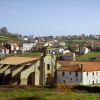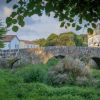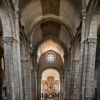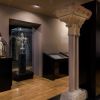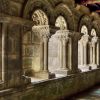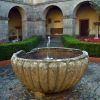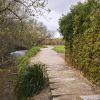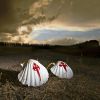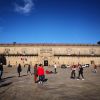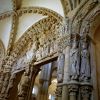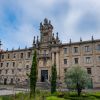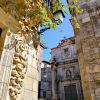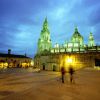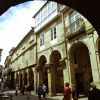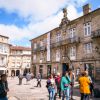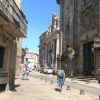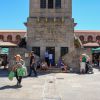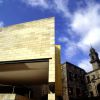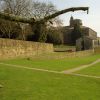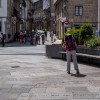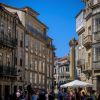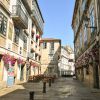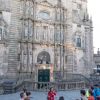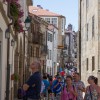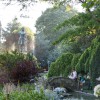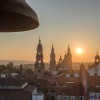- Accede I
- Regístrate I
- carrito
24. Colegiata de Sar
24. Colegiata de Sar
Galería de imágenes

Si abandonamos el habitual bullicio del centro de la urbe y nos dirigimos hacia el sudeste, a poco más de un kilómetro, podremos visitar el popular barrio de Sar, llamado así por el renombrado riachuelo que lo atraviesa de norte a sur. En su orilla, a pocos metros de un viejo puente de origen románico, por donde cruzan -aún hoy- los peregrinos que siguen la llamada vía de la Plata y los caminos del sudeste, se sitúa la magnífica Colegiata de Santa María la Mayor y Real de Sar.
Los trabajos de construcción de este edificio se iniciaron a comienzos del s. XII, siguiendo los deseos del canónico y tesorero de la catedral, Munio Alfonso, que para tal empresa contó con el apoyo decidido de su amigo y superior, el poderoso arzobispo Diego Gelmírez. Después de 22 años ocupando el cargo de obispo de Mondoñedo, Munio decidió retirarse voluntariamente en el año 1134, y lo hizo precisamente en las dependencias de este pequeño cenobio, cuyas obras nunca llegó a ver concluidas, pues falleció un par de años después.
Aunque los trabajos no se dieron por finalizados oficialmente hasta el s. XIII, fue precisamente Diego Gelmírez quien consagró la iglesia en el año 1140 y quien rubricó el diploma fundacional del pequeño monasterio, lo que sirvió para acoger en sus dependencias a la primera comunidad de agustinos de Galicia.
Durante los siguientes siglos, la comunidad vive una época de esplendor gracias a numerosas donaciones y exenciones por parte de la corona. Sin embargo, en el s. XVI, coincidiendo con la transformación del priorato en colegiata, y la posterior sustitución de la comunidad agustina por miembros del clero secular, comienza un periodo de declive que se acentúa a lo largo del s. XVII, momento en el que tanto la iglesia como su claustro sufren un evidente deterioro.
Ya durante el s. XVIII, en pleno auge del barroco compostelano, y gracias a la ayuda brindada por el monasterio de San Martiño Pinario, se llevan a cabo intensos trabajos de conservación y restauración, siguiendo para ello las recomendaciones e informes de algunos de los arquitectos más importantes del momento, como Domingo de Andrade o Fernando de Casas. Pero nuevamente, en el s. XIX, el edificio sufre un cierto abandono, y acaba convirtiéndose en una parroquia más de la Archidiócesis de Santiago de Compostela.
La magnífica iglesia conserva gran parte de su primitiva fábrica románica. En el exterior llaman la atención los robustos arbotantes construidos entre los siglos XVII y XVIII para proteger los muros septentrionales y evitar su derrumbe: bien fuese por un error técnico en la construcción, por la atrevida elevación de las naves laterales, por el corrimiento del inestable terreno sobre el que se asienta o simplemente por propia voluntad de quienes trabajaron en su construcción, los muros están visiblemente inclinados hacia el exterior, razón por la que hubo que rehacer la bóveda de cañón en su totalidad durante el siglo XVI.
El interior, de planta basilical y hermosas proporciones, impresiona a todo aquel que lo visita por la inclinación de las columnas hacia las naves laterales, proyectando una fuerte sensación de inestabilidad. La pila bautismal, a la derecha de la puerta principal, es una interesante pieza arqueológica del siglo XII.
El interior del templo se comunica a través de la sacristía con un magnífico claustro, el único de la ciudad con vestigios del original estilo románico. Tan solo se conserva una de las alas, el resto pertenece a los siglos XVII y XVIII. La fuente que ocupa el espacio central, muy similar a la que podemos observar también en el interior del claustro catedralicio, se remonta al s. XIII y fue construida en granito de una sola pieza.
Dentro del pequeño museo fundado en 1975 podremos admirar diversas piezas de importante valor histórico y documental, como el ya citado documento fundacional del templo, fechado en 1136 y sellado por el arzobispo Diego Gelmírez. En la sección dedicada a la orfebrería se pueden ver objetos litúrgicos realizados en talleres compostelanos durante el siglo XVIII. La colección arqueológica está formada por una serie de piezas del antiguo claustro románico, ligados estilísticamente al Maestro Mateo y su escuela. Entre estas piezas también podremos ver restos de los rosetones originales de época románica que presidían la fachada occidental de la iglesia y que fueron retirados en el s. XVIII.
Podremos despedirnos de este singular entorno paseando por los senderos de las “Brañas de Sar”. A lo largo de unos 4 km descubriremos el ambiente rural de Santiago de Compostela, con sembradíos, molinos, acequias, huertas y bosque de ribera. En realidad, una “braña” es una zona parcialmente anegada, situada a orillas de un río y que se mantiene verde durante todo el año. Antiguamente, las pequeñas explotaciones agrarias utilizaban estos terrenos para pasto del ganado.
A lo largo de nuestro recorrido podremos encontrarnos con numerosas especies de flora como sauces, robles, abedules o laureles, además de numerosas herbáceas. Las “brañas” también son refugio para diversas especies de fauna como anfibios, reptiles, aves y pequeños mamíferos. En definitiva, estamos ante un ecosistema riquísimo, pero también muy frágil, que cumple una función muy importante en la regulación del agua, puesto que la retiene cuando llueve en abundancia y evita que, de este modo, se produzcan repentinas crecidas e inundaciones.








